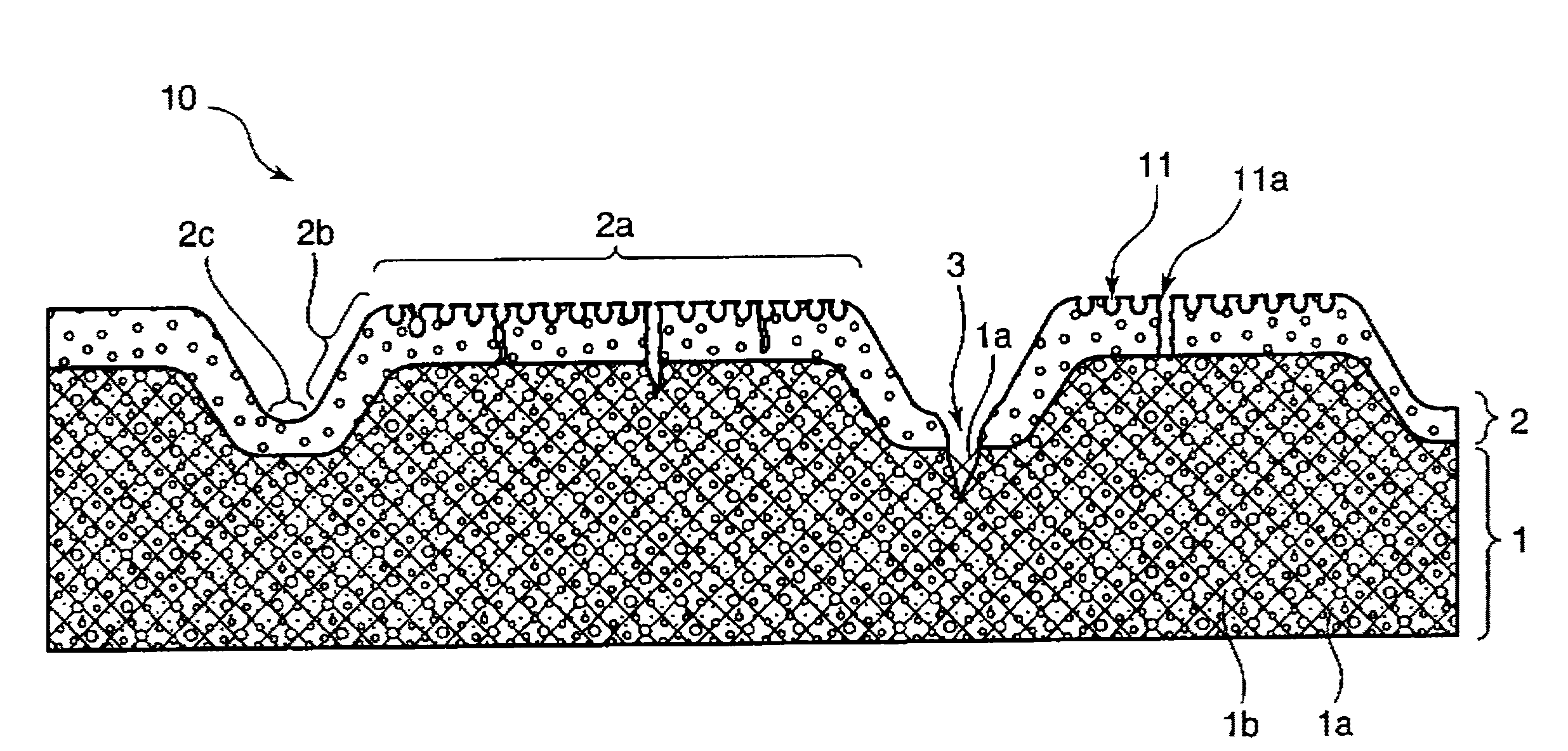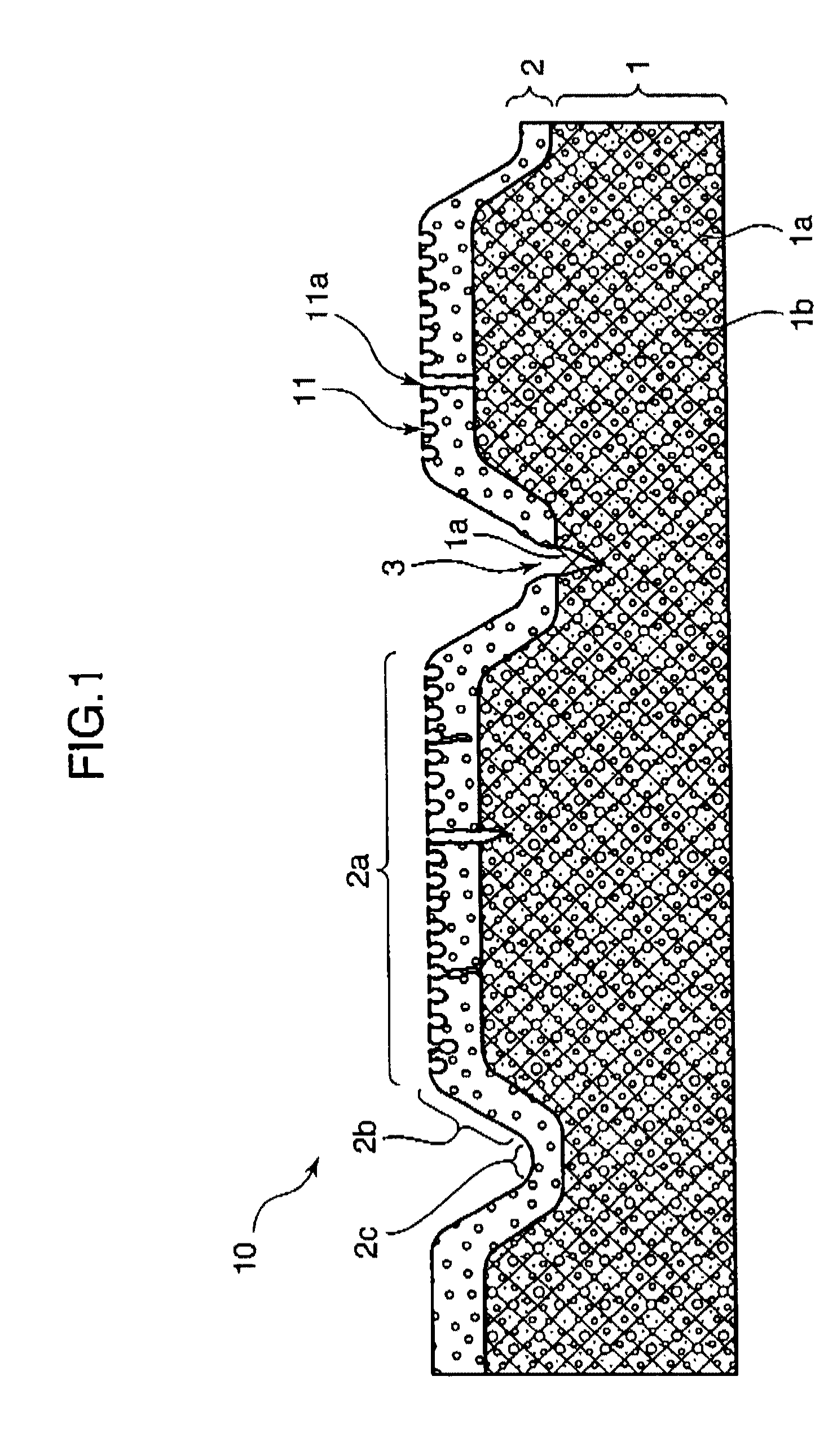Leather-like sheet and method of producing leather-like sheet
- Summary
- Abstract
- Description
- Claims
- Application Information
AI Technical Summary
Benefits of technology
Problems solved by technology
Method used
Image
Examples
example 1
[0130]A two-phase mixed spun fiber (sea-island type) composed of 6-nylon as an island component, and low-density polyethylene as a sea component (island component / sea component=50 / 50 (mass ratio)) was produced by melt-spinning. The fiber was subjected to drawing, crimping, and cutting. Thereby, fiber staples of 5 dtex and 51 mm in cut length were obtained.
[0131]The fiber staples were subjected to carding by a carding machine, and then, web pieces were prepared by a cross-lapper. A predetermined number of web pieces were laminated to a layered web. Then, a non-woven fabric of 450 g / m2 in unit area weight was obtained by subjecting the layered web to a needle punching treatment with use of a felting needle having one barb at a rate of 980 punches / cm2.
[0132]Subsequently, the non-woven fabric was heated and dried, and the surface of the non-woven fabric was made smooth by pressing. Then, the smoothed non-woven fabric was impregnated with a 16% polyether polyurethane DMP solution. Then, ...
example 2
[0140]Polyether polyurethane (“MP-145” of Dainippon Ink Chemical Industries Co., Ltd.) DMF solution (solid content: 20%) containing titanium oxide, a brown pigment, and a yellow pigment was coated in the amount of 400 g / m2 on a surface of a base material produced by the method described in Example 1. Then, the polyether polyurethane was coagulated in water, and dried. Thereby, a beige porous elastic resin layer of 500 μm in thickness was formed.
[0141]As a result of observing a surface of the porous elastic resin layer by the scanning electron microscope, it was confirmed that the resin layer surface had openings with a diameter from 10 to 500 nm at a density of about 7,000 openings / mm2. The average diameter of the openings was 150 nm.
[0142]Then, a leather-like sheet having a concave-convex configuration on a surface thereof was obtained by subjecting a surface of the base material having the porous elastic resin layer to an embossing treatment in the similar manner as Example 1 exce...
example 3
[0145]Polyether polyurethane (“MP-185” of Dainippon Ink Chemical Industries Co., Ltd.) DMF solution (solid content: 20%) containing titanium oxide, a brown pigment, and a yellow pigment was coated in the amount of 350 g / m2 on a surface of a base material produced by the method described in Example 1. Then, the polyether polyurethane was coagulated in water, and dried. Thereby, a beige porous elastic resin layer of 400 μm in thickness was formed.
[0146]As a result of observing a surface of the porous elastic resin layer by the scanning electron microscope, it was confirmed that the resin layer surface had openings with a diameter from 10 to 500 nm at a density of about 1,200 openings / mm2. The average diameter of the openings was 100 nm.
[0147]Then, a leather-like sheet having a concave-convex configuration on a surface thereof was obtained by subjecting a surface of the base material having the porous elastic resin layer to an embossing treatment in the similar manner as Example 1 exce...
PUM
| Property | Measurement | Unit |
|---|---|---|
| Nanoscale particle size | aaaaa | aaaaa |
| Thickness | aaaaa | aaaaa |
| Elasticity | aaaaa | aaaaa |
Abstract
Description
Claims
Application Information
 Login to View More
Login to View More - R&D
- Intellectual Property
- Life Sciences
- Materials
- Tech Scout
- Unparalleled Data Quality
- Higher Quality Content
- 60% Fewer Hallucinations
Browse by: Latest US Patents, China's latest patents, Technical Efficacy Thesaurus, Application Domain, Technology Topic, Popular Technical Reports.
© 2025 PatSnap. All rights reserved.Legal|Privacy policy|Modern Slavery Act Transparency Statement|Sitemap|About US| Contact US: help@patsnap.com



